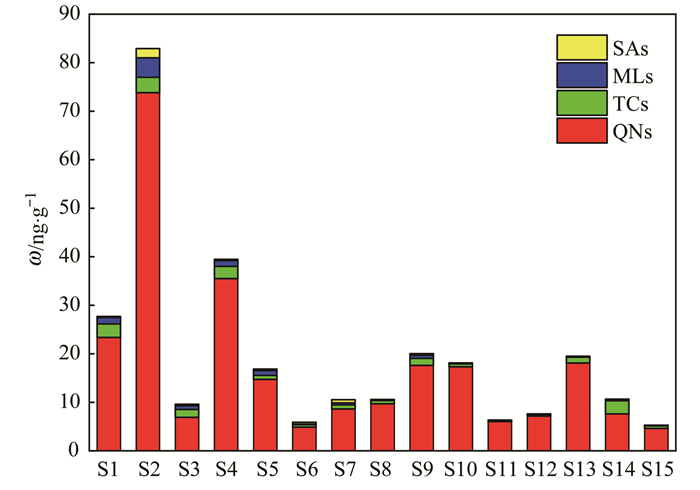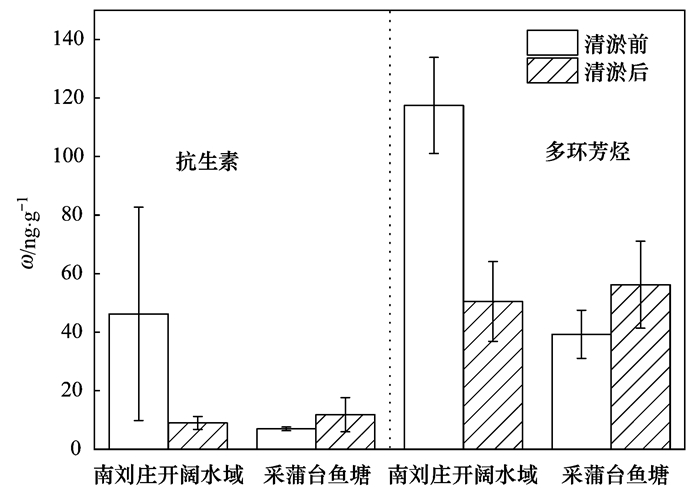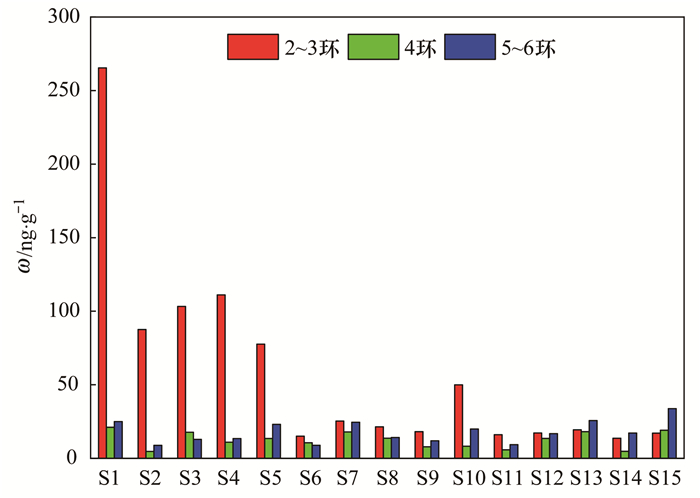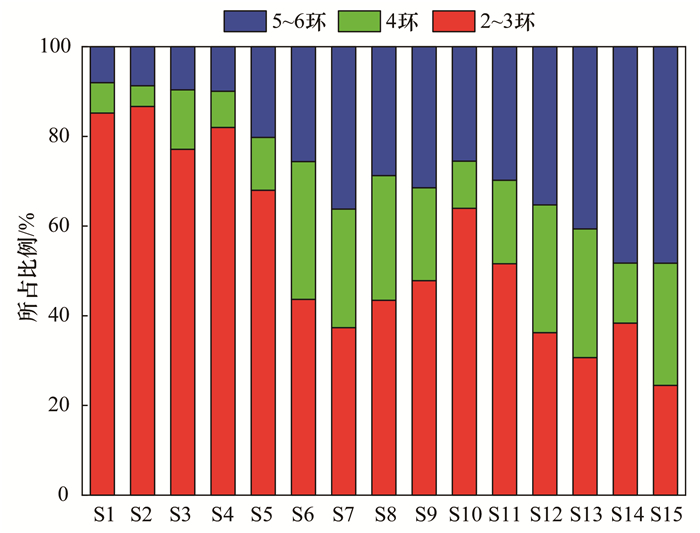2. 中国地质大学(武汉)环境学院, 武汉 430074;
3. 中国科学院生态环境研究中心环境水质学国家重点实验室, 北京 100085
2. School of Environment Studies, China University of Geosciences(Wuhan), Wuhan 430074, China;
3. State Key Laboratory of Environmental Aquatic Chemistry, Research Center for Eco-Environmental Sciences, Chinese Academy of Sciences, Beijing 100085, China
环境中的有机污染物通常毒性较大、难降解且积累性强, 严重影响了人体健康.通过对生态环境中有机污染物的调查分析, 甄别污染的严重和复杂程度是当前环境污染研究的重要方向之一.其中, 抗生素作为一类典型的新型有机污染物, 是药品与个人护理产品(PPCBs)的主要成分之一, 具有持久性及诱导环境生物菌群抗药性而产生潜在危险性等特点[1].据估计, 全世界每年的抗生素使用量在100 000~200 000 t之间, 广泛用于人类和牲畜[2].例如, 为治疗COVID-19病毒感染者, 大量抗生素在暴发初期被过度使用于患者, 现仍广泛用于治疗COVID-19引起的炎症[3].多环芳烃(polycyclic aromatic hydrocarbons, PAHs)是目前广受关注的另一类有机污染物, 是持久性有机污染物(POPs)的主要成分之一, 具有持久性、半挥发性、致畸、致癌性、生物蓄积性和远距离迁移等特点[4~6], 它们通过沉积、燃料排放和石油泄漏不断释放到水生生态系统中, 其中16种PAHs已被美国环保局列为优先控制的持久性有机污染物[7].
我国的污水处理厂(WWTP)面对抗生素使用量激增的现状, 处理效率明显降低而导致抗生素不可避免地释放到环境中.已有研究报道在地表水、地下水和饮用水中均检测出抗生素[8~12].目前国家对牲畜排放和水产养殖等没有具体处理要求, 牲畜粪便直接排放到河流或农业用地上的现象很普遍, 特别是基础设备有限的农村更缺乏处理抗生素的手段[13, 14]. Li等[15]研究在白洋淀水、沉积物和生物群样品中22种抗生素的存在和分布, 抗生素浓度的地理差异很大程度上是由于人类活动造成的.Meng等[16]综述了全球湖泊中多环芳烃的含量, 研究发现中国水环境的多环芳烃含量比国外高一个数量级, 沉积物中总多环芳烃的含量较低, 但大多数单个多环芳烃都存在潜在风险.位于华北的白洋淀是雄安新区重要的水资源, 具有“华北之肺”的美誉.随着河北省的人口密度不断增大, 人类活动直接或间接地影响了白洋淀的水生环境, 有机物污染[15]、重金属[17]和营养盐[18]等污染使得“华北之肺”的功能受到损害, 当务之急是开展白洋淀的水域生态修复.
白洋淀水域构造独特, 由143个淀泊构成, 各个淀区之间都是相互分割又相互联系的, 这与南方内陆湖泊和北方人工水库的水生环境截然不同[19].同时, 白洋淀复杂的水生环境还承担着水产养殖、收纳上游污水和水上娱乐等功能[20].曾经淀区大规模的水产养殖容易产生大量抗生素并在沉积物中富集, 柴油观光船以及附近村庄煤炭未完全燃烧也极易产生毒性较大的多环芳烃, 为保障淀区的水质安全, 调研附近水域沉积物中的抗生素和多环芳烃是白洋淀有机污染的重要研究方向.目前依托科技部的水专项, 白洋淀部分示范区已实施了清淤工程.因此有必要开展关于清淤前后水生环境中的有机污染物变化研究, 此前的研究多集中于白洋淀沉积物和水体中的有机污染物含量的调查以及清淤前后的氮磷释放改变, 而对于清淤前后有机污染物的变化研究较为缺乏.
为此, 本文选择白洋淀污染较为严重, 水生环境最为典型的清淤示范区采蒲台和南刘庄作为研究区域, 分别在两示范区的清淤和未清淤区域的开阔水域和鱼塘取样, 通过研究清淤前后沉积物中抗生素和多环芳烃的分布特征和风险评估, 以期为白洋淀进一步的科学清淤提供理论依据和实验数据参考.
1 材料与方法 1.1 样品的采集与处理2019年11月对白洋淀采蒲台和南刘庄清淤示范区区域分别进行取样, 如图 1所示.对上述区域两种最常见的水生环境(鱼塘、开阔水域)的清淤区域和未清淤区域分别取样, 在南刘庄未清淤区域采集5个表层样S1~S5和清淤区域采集3个表层样S6~S8; 采蒲台未清淤区域采集4个表层样S9~S12, 清淤区域采集3个表层样S13~S15, 采样点位置信息如表 1.用装有有机玻璃管(ϕ=85 mm)的柱状采泥器采集沉积物, 样品采集完后, 记录经纬度坐标、时间和位置信息, 24 h内运回实验室, 每5 cm切段, 取表层0~5 cm沉积物在实验室用冰箱储藏以备后续实验.将样品依次标号, 然后放入冷冻干燥机干燥2 d以上, 挑出样品中的芦苇树叶等杂物, 过60目筛, 将沉积物均匀混合, 分别装入样品袋, 冷冻保存.

|
图 1 采样点分布示意 Fig. 1 Distribution of sampling sites |
|
|
表 1 采样点信息和沉积物中有机碳含量 Table 1 Sampling sites and TOC in sediment |
1.2 仪器与试剂
所用的主要仪器有: 高效液相色谱-三重四极杆质谱(HPLC-MS/MS, Thermo, 美国), 气相质谱(GC-MS, Thermo, 美国), 快速溶剂萃取仪(ASE, Agilent, 美国), 固相萃取装置, 旋蒸仪, 氮吹仪, 真空冷冻干燥仪.其中沉积物中抗生素的净化采用waters HLB净化小柱(500 mg, 6 mL), 多环芳烃的净化采用waters硅酸镁净化小柱(500 mg, 6 mL).
本实验用有机溶剂为甲醇、乙腈、丙酮和正己烷, 二氯甲烷为色谱纯, 甲酸为分析纯.柠檬酸、磷酸氢二钠、氢氧化钠和乙二酸二乙酸钠均为分析纯, 盐酸为优级纯, 实验室用水皆为超纯水, 硅藻土在马弗炉中煅烧4 h, 冷却后密封保存在干燥箱中.
其中抗生素的标准品: 磺胺类8种, 大环内酯类4种, 四环素类4种, 喹诺酮类6种, 共22种.包括磺胺甲基嘧啶(SMR)、磺胺甲氧哒嗪(SMP)、磺胺二甲嘧啶(SMZ)、磺胺嘧啶(SDZ)、磺胺吡啶(SPD)、磺胺喹喔啉(SQX)、磺胺甲唑(SMX)、磺胺噻唑(STZ)、环丙沙星(CIP)、恩诺沙星(ENR)、洛美沙星(LOM)、诺氟沙星(NOR)、司帕沙星(SPA)、氧氟沙星(OFL)、四环素(TC)、强力霉素(DOC)、土霉素(OTC)、氯四环素(CTC)、克拉霉素(CTM)、阿奇霉素(AZM)、脱水红霉素(ETM-H2O)和罗红霉素(RTM)购自Dr. Ehrenstorfer(德国奥格斯堡). SMZ-d4作为内标, 购自ANPEL Laboratory Technologies(上海).多环芳烃标准品16种, 包含萘(Nap)、苊烯(Acy)、苊(Ace)、芴(Flu)、菲(Phe)、蒽(Ant)、荧蒽(Fla)、芘(Pyr)、苯并[a]蒽(BaA)、(Chry)、苯并[b]荧蒽(BbF)、苯并[k]荧蒽(BkF)、苯并[a]芘(BaP)、茚并[1, 2, 3-cd]芘(InP)、二苯并[a, h]蒽(DahA)和苯并[ghi]苝(BghiP).替代物为2-氟联苯, 购自阿拉丁(上海), 所有试剂均为分析纯.
1.3 分析方法 1.3.1 沉积物样品的预处理抗生素的预处理: 准确称取3 g沉积物样品于50 mL离心管中, 以甲醇/EDTA-Mcllvaine溶液(体积比为1 ∶1)混合溶剂为提取液, 超声提取, 萃取2次.提取液用0.1%的EDTA水溶液稀释到500 mL, 同时用盐酸调pH至4备用.HLB固相萃取小柱先分别用10 mL甲醇和10 mL超纯水活化, 然后将提取液以5 mL·min-1的流速通过柱子, 减压抽真空干燥0.5 h, 最后用10 mL甲醇洗脱.洗脱液在温和的氮气流下干燥至0.5 mL以下, 重新用超纯水溶解到2 mL棕色液相小瓶中, 通过孔径0.45 μm膜过滤后, 加入内标, 便可上机测试.
多环芳烃预处理: 准确称量5 g沉积物, 用硅藻土填充于萃取池中, 以丙酮/正己烷(体积比为1 ∶1)混合溶液为提取液, 快速溶剂萃取仪提取2次.其中萃取条件为温度100℃, 载气压力0.8 MPa, 萃取压力1 200~2 000 psi[(1 200~2 000)×6.9 kPa], 氮吹60 s, 萃取2次.提取液旋蒸浓缩至2 mL, 随后移至被二氯甲烷和正己烷活化后的硅酸镁小柱中净化, 用10 mL二氯甲烷和正己烷(体积比为1 ∶1)混合溶液洗脱, 氮吹近干, 选择丙酮正己烷(体积比为1 ∶1)混合溶液溶解, 移于棕色进样瓶, 待测.
1.3.2 仪器分析条件采用高效液相色谱-三重四极杆质谱(HPLC-MS/MS)分析沉积物中的抗生素.色谱条件: 色谱柱为Hypersil GOLDTM C18(100 mm×2.1 mm, 1.9 μm), 孔径17.5 nm, 波长UV@254 nm, 进样量10 μL, 柱背压6689 psi, 柱温35℃, 流动相A为乙腈流动相, B为0.1%的甲酸, 梯度洗脱程序见表 2, 流速为0.3 mL·min-1.质谱条件为数据采集方式: 选择反应检测(SRM), 采用电喷雾离子(ESI)源, 电离模式: ESI(+)和ESI(-)切换; 电离电压: 3.3 kV和-2.8 kV.传输毛细管温度: 325℃.
|
|
表 2 抗生素的梯度洗脱程序分离参数 Table 2 Parameters of gradient elution for the separation |
采用气相色谱质谱法分析沉积物中的多环芳烃.色谱柱为石英毛细管柱(30 m×0.25 mm, 0.25 μm, Thermo), 程序升温采用初始柱温80℃, 保持2 min; 以20℃·min-1速率升至180℃, 保持5 min; 再以10℃·min-1速率升至290℃, 保持5 min.柱流量为1 mL·min-1恒流, 进口温度280℃, 无分流.质谱参考条件选择离子模式(SIM), 采用电子轰击源(EI), 质量扫描范围: 45~450 u.
1.4 质量控制抗生素的测定采用内标法定量, 配置0、0.1、0.2、0.5、1.0、2.0、5.0、10.0、20.0、50.0和100.0 μg·L-1的标准液, 确定了校准曲线的线性关系(R2>0.999).各目标物的加标回收率为74.1% ~116.0%, 方法检出限在0.1~1.2 ng·g-1, 小于检出限的数据以“未检出(ND)”表示, 相对偏差小于10%.实验室空白样品石英砂中的抗生素浓度低于检出限, 所有实验室设备和玻璃仪器都用甲醇和超纯水冲洗, 防止交叉污染.
多环芳烃的测定采用外标法定量, 用空白实验, 基质加标, 平行样品质量控制.采用逐级稀释法, 配置成0、0.1、0.2、0.5、1.0、2.0和5.0 μg·L-1的标准液, 确定了校准曲线的线性关系(R2>0.995).替代物回收率2-氟联苯为73.1% ~113.8%, 平行样测定结果相对偏差小于30%.
1.5 风险评估方法抗生素的水生环境风险评估方法可选用风险商值法(RQ)[21], 由于抗生素类污染物在沉积物中对生物的毒理学数据有限, 因此, 通常的方法是将沉积物中抗生素的浓度通过辛醇/水分配系数转化为孔隙水中浓度, 再通过水体中抗生素的毒理学数据转化为沉积物的毒理学数据进行风险评估[22~24], 其公式如下:

|
(1) |

|
(2) |

|
(3) |

|
(4) |
式中, MEC为环境实测浓度, ng·g-1; PNECsediment为沉积物中无影响环境预测浓度, ng·g-1; PNECwater为水体中无影响环境预测浓度, 可从已有研究中获得, ng·L-1; Kd为沉积物-水分配系数; KOC为有机碳分配系数, 可由公式(4)中辛醇/水分配系数KOW推出, 单位均为L·kg-1; FOC为沉积物有机碳质量分数, g·g-1.根据RQ(风险商)数值的不同[25], 分为3个风险等级: 低风险(RQ<0.1)、中等风险(0.1≤RQ≤1)和高风险(RQ>1).
多环芳烃的水生环境风险评估方法可选用沉积物质量基准法, 根据Long等[26]的研究结果表明, 当沉积物中PAHs的浓度低于效应范围低值(ERL), 表示极少产生生物负面效应, 即生物毒性效应发生的概率小于10%; 当PAHs浓度高于效应范围中值(ERM)时, 发生生物毒性效应的概率高50%; 当PAHs浓度在ERL和ERM之间, 表明PAHs对生物产生的毒性效应较低, 发生的概率范围在10% ~50%之间.
2 结果与讨论 2.1 沉积物中抗生素含量分布沉积物样品抗生素的含量及检出率见表 3, 22种目标抗生素均有不同程度检出, 除STZ和CIP的检出率低于50%以外, 其它20种抗生素检出率均在60% ~100%之间.总体上, 抗生素含量水平处于未检出至52.89 ng·g-1之间, 四大类抗生素含量水平统计结果表明, 由高到低依次为喹诺酮类(QNs)、四环素类(TCs)、大环内酯类(MLs)和磺胺类(SAs), 其中QNs的含量占总含量的88%, 占主导地位. QNs中含量最高的抗生素为OFL, 最高的含量可达52.90 ng·g-1, 其次为ENR和NOR, 最高含量分别为14.50 ng·g-1和13.93 ng·g-1. QNs与其它3类抗生素相比, 更容易与阳离子螯合并与颗粒物质牢牢结合, 因此容易吸附到沉积物上, 且难被生物降解导致不断累积[15, 22, 27].
|
|
表 3 白洋淀不同区域沉积物抗生素含量及检出率 Table 3 Content and detection rate of antibiotics in sediments from different areas of Baiyangdian Lake |
在15个采样点中, S1~S8为南刘庄区域采样点, S9~S15为采蒲台区域采样点.如图 2所示, 在空间分布上, 南刘庄区域沉积物的抗生素含量明显高于采蒲台区域, S2和S3为南刘庄开阔水域, 抗生素的平均含量为46.25 ng·g-1, 远高于采蒲台开阔水域S9和S10的抗生素平均含量19.07 ng·g-1; 南刘庄鱼塘S4、S5的抗生素含量也明显高于采蒲台区域S11和S12.由于保定市的市政污水和工业废水, 尤其是造纸厂废水, 不断将污染物通过府河汇入白洋淀南刘庄区域, 其中府河是白洋淀的主要水源[28~30].对于清淤和未清淤区而言, 如图 3所示, 南刘庄开阔水域清淤后的抗生素含量为S6~S8的平均值, 清淤后抗生素的平均含量为9 ng·g-1, 降低了80.54%, 清淤效果明显; 对于采蒲台鱼塘而言, 清淤后抗生素含量变化不大, 因为采蒲台鱼塘区域众多且复杂, 未清淤鱼塘可能在政府禁止养鱼之前就已实施清淤, 从而导致后续清淤的效果不明显.

|
图 2 白洋淀沉积物中抗生素的含量分布 Fig. 2 Content distribution of antibiotics in sediments of Baiyangdian Lake |

|
图 3 白洋淀清淤前后抗生素和多环芳烃的含量变化 Fig. 3 Content changes of antibiotics and PAHs in Baiyangdian Lake before and after dredging |
从表 4可以看出, 16种PAHs均有检出, 其中南刘庄区域沉积物中PAHs的含量范围为23.79~329.40 ng·g-1, 平均含量118.44 ng·g-1; 采蒲台区域PAHs含量范围为22.04~188.33 ng·g-1, 平均含量51.89 ng·g-1.其中Nap含量最高, 达到242.02 ng·g-1, 其次为Chry和BkF, Flu的含量最低.如图 4所示, 位于府河区域的S1点PAHs总量最高, 南刘庄鱼塘的PAHs平均含量略高于开阔水域.从图 3可见南刘庄开阔水域未清淤区域的PAHs平均含量为117.45 ng·g-1, 清淤后多环芳烃含量减少了57.01%, 为50.49 ng·g-1; 采蒲台区域的S7~S15中, 开阔水域的PAHs平均含量明显高于鱼塘, 且鱼塘清淤前后PAHs的变化不大.
|
|
表 4 白洋淀不同区域沉积物PAHs的含量 /ng·g-1 Table 4 Contents of PAHs in sediments from different areas of Baiyangdian Lake /ng·g-1 |

|
图 4 白洋淀沉积物中不同环数多环芳烃的含量分布 Fig. 4 Content distribution of PAHs in sediments of Baiyangdian Lake |
图 5可知, 南刘庄区域沉积物主要以2~3环的PAHs为主, 采蒲台区域5~6环的PAHs占比明显增大.PAHs污染主要来自人为源, 包括各种矿物污染物的未完全燃烧和还原热解, 其中多环芳烃环数的相对含量可以一定程度上反映来自石油类或热解的污染[31, 32].4环以上PAHs通常为化石高温燃烧, 2~3环主要为石油污染.因此, 南刘庄多环芳烃主要以2~3环为主的原因可能是游船或清淤船带来的油类污染严重, 采蒲台区域的5~6环可能由于附近村庄冬天存在烧煤取暖造成的.

|
图 5 白洋淀沉积物中不同环数多环芳烃的组成分布 Fig. 5 Distribution of PAHs in sediments of Baiyangdian Lake |
表 5为抗生素对应最敏感物种的毒理学数据和KOW数据, 通过已有研究收集, PNECwater值选取最常见和敏感的物种获得, MEC值选取15个采样点中抗生素的最高含量, FOC数据同沉积物总有机碳含量见表 1, 选取MEC值对应的采样点的总有机碳浓度, 通过公式(1)计算RQ值, 见表 6.喹诺酮类抗生素处于中高等风险水平, 其中ENR和NOR为高等风险, OFL处于中风险, SAs中SMX为中等风险, TCs和MLs为低风险, 说明喹诺酮类抗生素对白洋淀生态环境存在潜在威胁.从空间上看, 最高浓度的QNs都集中在点位S2, 该区域为高风险区, 南刘庄部分开阔水域的鱼塘、采蒲台区域的鱼塘和开阔水域均为低风险, 且南刘庄清淤后的开阔水域S6生态风险最低.
|
|
表 5 抗生素的KOW和PNEC数据 Table 5 Organic carbon partitioning coefficient and PNEC of antibiotics |
|
|
表 6 白洋淀沉积物抗生素的风险商值 Table 6 RQ of the antibiotics in Baiyangdian Lake |
喹诺酮类抗生素是人畜通用的药物, 主要用于畜牧和水产养殖, 白洋淀在清淤前曾广泛养殖禽类, 导致部分区域沉积物中QNs抗生素基本为中高风险, 清淤后风险明显降低.沉积物中抗生素会不断释放到水体环境中, 进入人体而富集, 危害人体健康.综上所述, 白洋淀未清淤区域的喹诺酮抗生素风险不容忽视, 且已实施的清淤工程对抗生素的去除具有明显效果.
2.4 多环芳烃的风险评估白洋淀沉积物PAHs的风险评估可知(表 7), 由沉积物质量基准法评价标准, 15个采样点中仅S1府河区域的Nap的含量超过ERL值, 但远低于ERM, 存在10% ~50%的概率对生物造成较低的毒性效应, 其他区域的沉积物中16种PAHs和总PAHs的含量均低于ERL, 总体上白洋淀沉积物中PAHs的风险评估为低风险.与国内其他河流的PAHs对比[16], 白洋淀的含量明显较低, 多环芳烃通常来源于石油等化石燃料燃烧, 说明自雄安新区设立以来, 政府大力治理环境已初见成效.
|
|
表 7 白洋淀PAHs的风险评估 Table 7 Risk assessment of PAHs in Baiyangdian Lake |
3 结论
(1) 在白洋淀清淤示范区沉积物中22种抗生素和16种多环芳烃均有检出, 抗生素中以喹诺酮类的含量最高, 因为喹诺酮类抗生素容易吸附在沉积物上不易被降解; 多环芳烃中3环以下的烃类含量较高, 可能与白洋淀区域游船燃料的未完全燃烧有关.
(2) 在南刘庄开阔水域S2的沉积物中抗生素含量最高, 南刘庄开阔水域清淤后抗生素总量减少了80.54%; PAHs在S1府河区域沉积物中的含量最高, 南刘庄开阔水域清淤后PAHs含量减少了57.01%, 充分说明清淤降低了南刘庄开阔水域沉积物中抗生素和多环芳烃的含量.
(3) 抗生素的生态风险评估整体处于中低风险水平, 但位于S2的南刘庄开阔水域QNs生态风险为中高风险, 其中ENR和NOR处于高风险, 说明喹诺酮类抗生素对白洋淀生态环境存在潜在威胁; 多环芳烃的风险评估显示, 除S1府河的Nap处于中风险外, 其它区域均处于低风险.
| [1] | Nantaba F, Wasswa J, Kylin H, et al. Occurrence, distribution, and ecotoxicological risk assessment of selected pharmaceutical compounds in water from Lake Victoria, Uganda[J]. Chemosphere, 2020, 239. DOI:10.1016/j.chemosphere.2019.124642 |
| [2] | Jeong J, Song W H, Cooper W J, et al. Degradation of tetracycline antibiotics: mechanisms and kinetic studies for advanced oxidation/reduction processes[J]. Chemosphere, 2010, 78(5): 533-540. DOI:10.1016/j.chemosphere.2009.11.024 |
| [3] | Chen Z J, Guo J S, Jiang Y X, et al. High concentration and high dose of disinfectants and antibiotics used during the COVID-19 pandemic threaten human health[J]. Environmental Sciences Europe, 2021, 33(1): 11. DOI:10.1186/s12302-021-00456-4 |
| [4] | Li Y, Liu M, Hou L J, et al. Geographical distribution of polycyclic aromatic hydrocarbons in estuarine sediments over China: human impacts and source apportionment[J]. Science of the Total Environment, 2021, 768. DOI:10.1016/j.scitotenv.2021.145279 |
| [5] | Abayi J J M, Gore C T, Nagawa C, et al. Polycyclic aromatic hydrocarbons in sediments and fish species from the White Nile, East Africa: bioaccumulation potential, source apportionment, ecological and health risk assessment[J]. Environmental Pollution, 2021, 278. DOI:10.1016/j.envpol.2021.116855 |
| [6] | Zheng B H, Wang L P, Lei K, et al. Distribution and ecological risk assessment of polycyclic aromatic hydrocarbons in water, suspended particulate matter and sediment from Daliao River estuary and the adjacent area, China[J]. Chemosphere, 2016, 149: 91-100. DOI:10.1016/j.chemosphere.2016.01.039 |
| [7] | Yuan Z J, He B B, Wu X G, et al. Polycyclic aromatic hydrocarbons(PAHs) in urban stream sediments of Suzhou Industrial Park, an emerging eco-industrial park in China: occurrence, sources and potential risk[J]. Ecotoxicology and Environmental Safety, 2021, 214. DOI:10.1016/j.ecoenv.2021.112095 |
| [8] |
赵卫凤, 鲍晓磊, 张媛, 等. 河北省发酵类抗生素菌渣处置现状及存在的问题[J]. 安徽农业科学, 2013, 41(31): 12417-12421. Zhao W F, Bao X L, Zhang Y, et al. Investigation on status of antibiotics fermentation residues and existing problems in Hebei[J]. Journal of Anhui Agricultural Sciences, 2013, 41(31): 12417-12421. DOI:10.3969/j.issn.0517-6611.2013.31.064 |
| [9] | Tong L, Qin L T, Guan C, et al. Antibiotic resistance gene profiling in response to antibiotic usage and environmental factors in the surface water and groundwater of Honghu Lake, China[J]. Environmental Science and Pollution Research, 2020, 27(25): 31995-32005. DOI:10.1007/s11356-020-09487-5 |
| [10] | Kovalakova P, Cizmas L, McDonald T J, et al. Occurrence and toxicity of antibiotics in the aquatic environment: a review[J]. Chemosphere, 2020, 251. DOI:10.1016/j.chemosphere.2020.126351 |
| [11] | Tran N H, Reinhard M, Gin K Y H. Occurrence and fate of emerging contaminants in municipal wastewater treatment plants from different geographical regions-a review[J]. Water Research, 2018, 133: 182-207. DOI:10.1016/j.watres.2017.12.029 |
| [12] | Watkinson A J, Murby E J, Kolpin D W, et al. The occurrence of antibiotics in an urban watershed: from wastewater to drinking water[J]. Science of the Total Environment, 2009, 407(8): 2711-2723. DOI:10.1016/j.scitotenv.2008.11.059 |
| [13] | Azuma T, Otomo K, Kunitou M, et al. Environmental fate of pharmaceutical compounds and antimicrobial-resistant bacteria in hospital effluents, and contributions to pollutant loads in the surface waters in Japan[J]. Science of the Total Environment, 2019, 657: 476-484. DOI:10.1016/j.scitotenv.2018.11.433 |
| [14] | Zhou L J, Ying G G, Zhao J L, et al. Trends in the occurrence of human and veterinary antibiotics in the sediments of the Yellow River, Hai River and Liao River in northern China[J]. Environmental Pollution, 2011, 159(7): 1877-1885. |
| [15] | Li W H, Shi Y L, Gao L H, et al. Occurrence of antibiotics in water, sediments, aquatic plants, and animals from Baiyangdian Lake in North China[J]. Chemosphere, 2012, 89(11): 1307-1315. DOI:10.1016/j.chemosphere.2012.05.079 |
| [16] | Meng Y, Liu X H, Lu S Y, et al. A review on occurrence and risk of polycyclic aromatic hydrocarbons(PAHs) in lakes of China[J]. Science of the Total Environment, 2019, 651: 2497-2506. DOI:10.1016/j.scitotenv.2018.10.162 |
| [17] | Zhang C, Shan B Q, Zhao Y, et al. Spatial distribution, fractionation, toxicity and risk assessment of surface sediments from the Baiyangdian Lake in northern China[J]. Ecological Indicators, 2018, 90: 633-642. DOI:10.1016/j.ecolind.2018.03.078 |
| [18] |
刘鑫, 史斌, 孟晶, 等. 白洋淀水体富营养化和沉积物污染时空变化特征[J]. 环境科学, 2020, 41(5): 2127-2136. Liu X, Shi B, Meng J, et al. Spatio-temporal variations in the characteristics of water eutrophication and sediment pollution in Baiyangdian Lake[J]. Environmental Science, 2020, 41(5): 2127-2136. |
| [19] | Yang W, Yan J, Wang Y, et al. Seasonal variation of aquatic macrophytes and its relationship with environmental factors in Baiyangdian Lake, China[J]. Science of the Total Environment, 2020, 708. DOI:10.1016/j.scitotenv.2019.135112 |
| [20] |
张盼伟. 海河流域典型水体中PPCPs的环境行为及潜在风险研究[D]. 北京: 中国水利水电科学研究院, 2018. Zhang P W. Environmental behavior and pollution characteristics of pharmaceuticals and personal care products, and their associated environmental risks in typical water-body from Haihe River basin, China[D]. Beijing: China Institute of Water Resources and Hydropower Research, Beijing, China, 2018. http://cdmd.cnki.com.cn/article/cdmd-82301-1018178139.htm |
| [21] | Gros M, Petrović M, Ginebreda A, et al. Removal of pharmaceuticals during wastewater treatment and environmental risk assessment using hazard indexes[J]. Environment International, 2010, 36(1): 15-26. DOI:10.1016/j.envint.2009.09.002 |
| [22] | Hu Y, Yan X, Shen Y, et al. Antibiotics in surface water and sediments from Hanjiang River, Central China: occurrence, behavior and risk assessment[J]. Ecotoxicology and Environmental Safety, 2018, 157: 150-158. DOI:10.1016/j.ecoenv.2018.03.083 |
| [23] | Chen K, Zhou J L. Occurrence and behavior of antibiotics in water and sediments from the Huangpu River, Shanghai, China[J]. Chemosphere, 2014, 95: 604-612. DOI:10.1016/j.chemosphere.2013.09.119 |
| [24] |
周力, 刘珊, 郭家骅, 等. 基于生态风险的我国水环境高风险抗生素筛选排序[J]. 环境科学, 2021, 42(6): 2748-2757. Zhou L, Liu S, Guo G H, et al. Screening and sequencing of high-risk antibiotics in China's water environment based on ecological risks[J]. Environmental Science, 2021, 42(6): 2748-2757. |
| [25] | Hernando M D, Mezcua M, Fernández-Alba A R, et al. Environmental risk assessment of pharmaceutical residues in wastewater effluents, surface waters and sediments[J]. Talanta, 2006, 69(2): 334-342. DOI:10.1016/j.talanta.2005.09.037 |
| [26] | Long E R, Macdonald D D, Smith S L, et al. Incidence of adverse biological effects within ranges of chemical concentrations in marine and estuarine sediments[J]. Environmental Management, 1995, 19(1): 81-97. DOI:10.1007/BF02472006 |
| [27] | Moreno-Bondi M C, Marazuela M D, Herranz S, et al. An overview of sample preparation procedures for LC-MS multiclass antibiotic determination in environmental and food samples[J]. Analytical and Bioanalytical Chemistry, 2009, 395(4): 921-946. DOI:10.1007/s00216-009-2920-8 |
| [28] | Cui B S, Li X, Zhang K J. Classification of hydrological conditions to assess water allocation schemes for Lake Baiyangdian in North China[J]. Journal of Hydrology, 2010, 385(1-4): 247-256. DOI:10.1016/j.jhydrol.2010.02.026 |
| [29] | Su L Y, Liu J L, Christensen P. Spatial distribution and ecological risk assessment of metals in sediments of Baiyangdian wetland ecosystem[J]. Ecotoxicology, 2011, 20(5): 1107-1116. DOI:10.1007/s10646-011-0616-2 |
| [30] | Zhang L L, Shen L N, Qin S, et al. Quinolones antibiotics in the Baiyangdian Lake, China: occurrence, distribution, predicted no-effect concentrations(PNECs) and ecological risks by three methods[J]. Environmental Pollution, 2020, 256. DOI:10.1016/j.envpol.2019.113458 |
| [31] |
杨帆, 罗红雪, 钟艳霞, 等. 宁东能源化工基地核心区表层土壤中多环芳烃的空间分布特征、源解析及风险评价[J]. 环境科学, 2021, 42(5): 2490-2501. Yang F, Luo H X, Zhong Y X, et al. Spatial distribution characteristics, source apportionment, and risk assessment of topsoil PAHs in the core area of the Ningdong energy and chemical industry base[J]. Environmental Science, 2021, 42(5): 2490-2501. |
| [32] |
胡国成, 郭建阳, 罗孝俊, 等. 白洋淀表层沉积物中多环芳烃的含量、分布、来源及生态风险评价[J]. 环境科学研究, 2009, 22(3): 321-326. Hu G C, Guo J Y, Luo X J, et al. Distribution, sources, and risk assessment of polycyclic aromatic hydrocarbons(PAHs) in surface sediments from Baiyangdian Lake[J]. Research of Environmental Sciences, 2009, 22(3): 321-326. |
| [33] | Ferrari B, Mons R, Vollat B, et al. Environmental risk assessment of six human pharmaceuticals: are the current environmental risk assessment procedures sufficient for the protection of the aquatic environment?[J]. Environmental Toxicology and Chemistry, 2004, 23(5): 1344-1354. DOI:10.1897/03-246 |
| [34] | Isidori M, Lavorgna M, Nardelli A, et al. Model study on the effect of 15 phenolic olive mill wastewater constituents on seed germination and Vibrio fischeri metabolism[J]. Journal of Agricultural and Food Chemistry, 2005, 53(21): 8414-8417. DOI:10.1021/jf0511695 |
| [35] |
彭秋, 王卫中, 徐卫红. 重庆市畜禽粪便及菜田土壤中四环素类抗生素生态风险评价[J]. 环境科学, 2020, 41(10): 4757-4766. Peng Q, Wang W Z, Xu W H. Ecological risk assessment of tetracycline antibiotics in livestock manure and vegetable soil of Chongqing[J]. Environmental Science, 2020, 41(10): 4757-4766. |
 2021, Vol. 42
2021, Vol. 42


